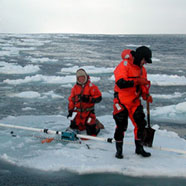Cryospheric and Polar Processes Division
Richard Armstrong, Division Director
The importance of cryospheric and polar processes to global climate has been documented by both observational and modeling studies, but many questions remain. Cryospheric and Polar Processes Division research at CIRES combines data collection, modeling, and data analysis to improve the understanding of how the cryosphere influences, and responds to, changes in the global climate.
 Much of this work takes advantage of the resources of the National Snow and Ice Data Center [ About NSIDC ] / World Data Center for Glaciology (NSIDC/WDC), which CIRES operates under contract to NOAA's National Geophysical Data Center (NGDC). In addition, a major effort is archiving and distributing satellite information pertaining to the cryosphere in the Snow and Ice Distributed Active Archive Center (DAAC) as a part of NASA's Earth Observing System (EOS) Data and Information Center. These centers also serve as the archive for snow, ice, and frozen ground products derived from the Special Sensor Microwave Imager (SSM/I) instrument on the Defense Meteorological Satellite Program (DMSP) platform, and the NASA EOS sensors, MODIS and AMSR-E. These data greatly enhance efforts to understand variability in the cryosphere and its relationship to global climate.
Much of this work takes advantage of the resources of the National Snow and Ice Data Center [ About NSIDC ] / World Data Center for Glaciology (NSIDC/WDC), which CIRES operates under contract to NOAA's National Geophysical Data Center (NGDC). In addition, a major effort is archiving and distributing satellite information pertaining to the cryosphere in the Snow and Ice Distributed Active Archive Center (DAAC) as a part of NASA's Earth Observing System (EOS) Data and Information Center. These centers also serve as the archive for snow, ice, and frozen ground products derived from the Special Sensor Microwave Imager (SSM/I) instrument on the Defense Meteorological Satellite Program (DMSP) platform, and the NASA EOS sensors, MODIS and AMSR-E. These data greatly enhance efforts to understand variability in the cryosphere and its relationship to global climate.
 Research Foci
Research Foci
